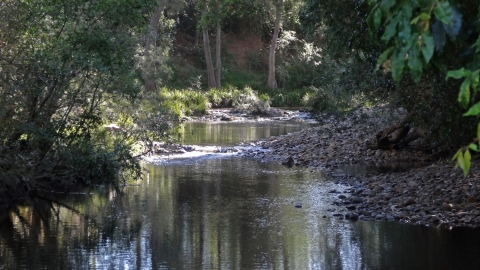- Home
- Assessments
- Bioregional Assessment Program
- Methods
- Surface water modelling
- 6 Modelling the impacts of coal resource development
Coal resource developments may include open-cut and underground coal mining and coal seam gas extraction. There are many similarities in how these different types of extractive industries manage water and how this affects streamflow generation (see product 2.3 (conceptual modelling) for details). The water management processes that will be considered in the surface water modelling are outlined below.
6.1 Groundwater pumping
The dewatering of coal mines and depressurisation of CSG fields will lead to the development of drawdown cones in groundwater levels. These reductions in groundwater levels have the potential to reduce the discharge of baseflow from the groundwater to the stream. This reduction will be modelled in the surface water – groundwater modelling. The impact on baseflow predicted there will then be applied to reduce river flows in a post-processing step in the surface water modelling.
6.2 Interception of surface runoff
An open-cut coal mine is likely to change surface runoff conditions considerably. The disturbed area may be converted from deep-rooted forest to bare soil or short-rooted vegetation. This will necessitate a transition within AWRA from the deep-rooted hydrological response unit (HRU) to the shallow-rooted HRU. This, in turn, is likely to lead to reductions in canopy interception of rainfall. While surface runoff from outside the footprint of the disturbed area is likely to be diverted around and past the tenement, any surface runoff generated on site is likely to be retained on site, with some of it used for dust suppression or coal washing. Thus, the presence of an open-cut mine is likely to reduce natural surface runoff to the stream network. Furthermore, the amount of interception (i.e. the size of the footprint) is likely to change considerably over time.
6.3 Extraction of water from streams
Where there is a proposal for a mine or CSG field to extract water directly from the stream network, we will need a time series of extracted volumes. We will not model the decision-making processes that lead to variations in the timing and volume of extractions. Any such extractions can be deducted from modelled flow in that stream.
Note that there may be some subregions or jurisdictions where direct extraction is only allowed through the purchase of licences from existing water users. Extraction through this mechanism might not substantially change the total extraction from the stream, but it might alter its timing.
6.4 Discharge of mine water and co-produced water
Water sourced from groundwater pumping, interception of surface runoff or extraction from streams may be temporarily stored on site. There are a number of potential fates for this water. Some of it is likely to be used on site for washing coal, damping roads, etc. In some developments, the water may be used for irrigation of on-site or nearby crops. In some developments it may be left indefinitely in storage to evaporate or may be trucked off site. Some developments may be licensed to discharge water directly to the stream. In the latter case, this discharge may be strictly regulated and only allowed during favourable conditions. Such conditions might be when natural river flows are high and the discharge is not likely to affect the quality of the river flows.
Depending on the fate of stored or produced water, the surface water modelling in some regions may require the explicit modelling of storage volumes. In some subregions (e.g. Hunter) the discharge of stored water is regulated by a permit system in which mining companies buy discharge permits at auction and are allowed to trade permits with other producers. We will not directly model this water-trading system since it is governed by human decision-making. Nonetheless, the surface water modelling will allow automatic discharges to the stream when flow condition triggers are met.
6.5 Subsidence
Subsidence of material above a longwall coal mine has the potential to change the surface landscape to such an extent that the generation of surface runoff or its flow paths are altered. These changes may, in turn, alter the hydrology of nearby wetlands. Subsidence may also result in increased surface ponding, which will, in turn, mean that some runoff water could evaporate or recharge rather than reach the natural drainage network. Any changes to surface runoff can be accounted for in surface water modelling.

METHODOLOGY FINALISATION DATE
- 1 Background and context
- 2 Components of surface water modelling
- 3 Streamflow modelling
- 4 River system modelling
- 5 Constituent modelling
- 6 Modelling the impacts of coal resource development
- 7 Linkages with other modelling components
- 8 Outputs from surface water modelling
- Appendix A Modifications to AWRA-R
- Appendix B Proposed structure of product 2.6.1 (surface water numerical modelling) and product 2.5 (water balance assessment)
- References
- Datasets
- Citation
- Acknowledgements
- Contributors to the Technical Programme
- About this submethodology
